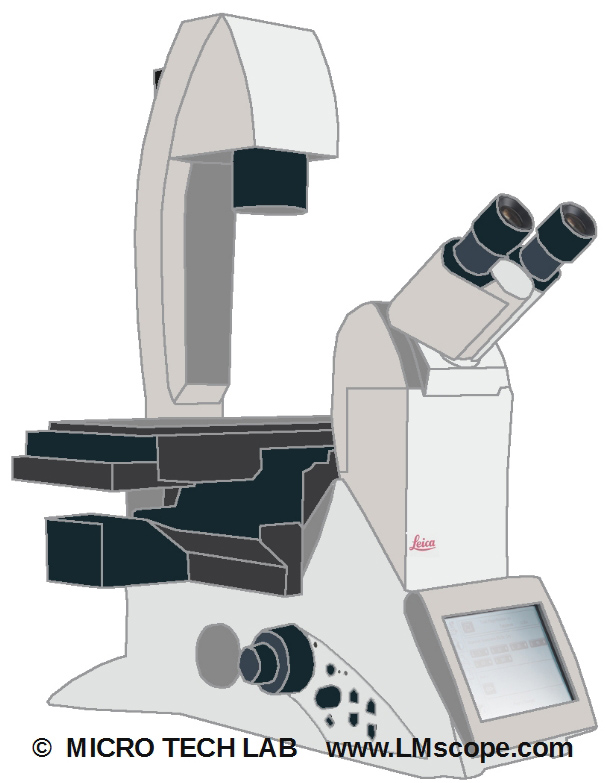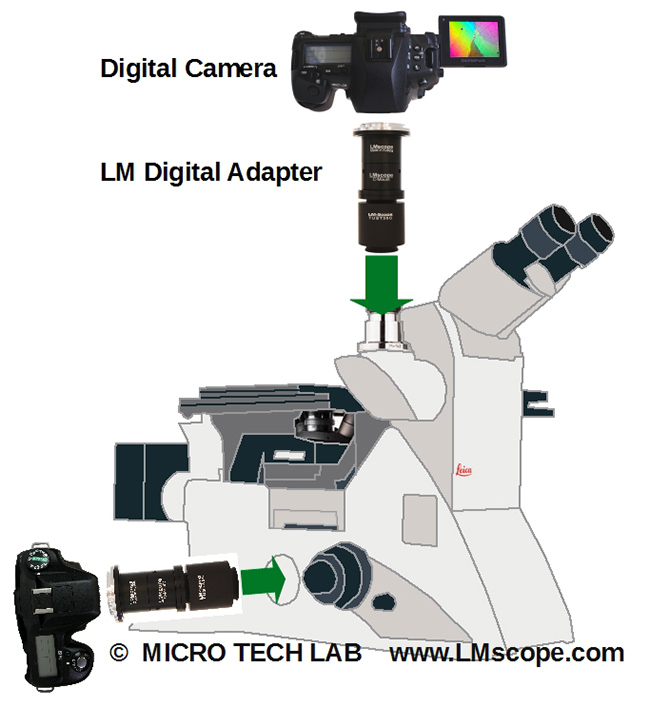

The Leica DMi8 – an inverted microscope featuring a modular design
Get better image quality with LM adapter solutions for digital cameras – the perfect link between the Leica DMi8 and DSLR or mirrorless system cameras!
Irrespective of the specific imaging tasks you want to perform, your microscope should always be tailored exactly to your needs. The modular design of the Leica DMi8 enables configuration of a basic system for industry applications, while leaving the option open to incorporate modifications and upgrades at a later date.

The key advantage of inverted microscopes is that they speed up the workflow because they achieve a higher sample throughput and their large working space can also accommodate large and heavy samples.
The Leica DMi8 comes in three versions: the DMi8 M, the DMi8 C and the DMi8 A. They all support the following contrasting techniques: bright field, DIC, polarisation and UC-3D (Ultra-Contrast 3D) illumination, which allows the user to illuminate the sample from different angles, thus making it possible to obtain additional information on the surface structure and achieve improved contrast. The DMi8 C and DMi8 A additionally offer transmitted light imaging with bright field, polarisation, phase contrast, DIC and dark field as well as the incident light techniques HDF and fluorescence.
All three models have a 6-fold objective turret (coded option: M32; motorized option: M25). The base is available with and without display, function buttons and touchscreen, and users can also choose from manual and motorised focusing options.
Leica also offers a macro objective that provides four times the field of view compared to conventional objectives (35.7mm at 0.7x magnification).
The different models have the following characteristics:
Leica DMi8 M: Basic system for simple routine tasks, manual 2-gear focus drive, supports the most common contrasting techniques, all contrast modes with LED illumination, illumination control, Leica Application Suite software
Leica DMi8 C: Coded components to ensure reproducible results, manual 2- or 3-gear focus drive, coded objective turret, coded or uncoded reflector turret, UC-3D illumination, supports all major contrasting techniques, IL/TL switch, LED illumination, intensity manager, Leica Application Suite software. The DMi8 C is also available with a photo port, which, combined with our LM digital adapters, makes it possible to attach almost all DSLR and system cameras to the microscope in a few easy steps.

Leica DMi8 A: Motorised system for demanding research application, motorised or 3-gear focus drive, 6-fold objective turret (motorised or coded), reflector turret (motorised or coded), manual or motorised UC-3D illumination, supports all major contrasting techniques, LED illumination, illumination and contrast management with diaphragm unit, Leica Application Suite software.
In addition to the top camera port, the Leica DMi8 A also has a side port which can be used to connect a camera to the microscope. Leica has enlarged the field of view (FOV) for all camera ports. Optimised for state-of-the-art sCMOS cameras, the Leica DMi8 has a 19mm FOV compared to 16mm standard camera ports.
In addition, users can see more through the eyepieces with up to 25 mm FOV.
Photography:
Fitting the microscope to digital single-lens reflex (DSLR), mirrorless interchangeable-lens cameras (MILC ), digital single-lens mirrorless (DSLM) or C-mount cameras is easy with our LM digital SLR adapters, which feature a plan achromatic optical system. Our products make it possible to capture top-quality microscope images. To help you select the adapter that is right for your camera, we have set up an online configurator on our website. You can also email us – ideally with attached photographs of your microscope.
Modern DSLR and single-lens mirrorless (DSLM) offer the latest technology and are generally very well suited for microscopy applications. Most of them can be controlled remotely via PC/Mac. Because of their high sales volumes, they offer an excellent price/performance ratio compared to special-purpose microscope cameras.
Features of top DSLR and single-lens mirrorless cameras (DSLM):
- Large, powerful full-frame sensors (36 x 24 mm)
- Sensor resolution of 61 megapixels or 240 megapixels with Pixel Shift technology
- High light sensitivity (ISO 400,000+)
- Extensive dynamic range (up to 15 aperture stops/f-stops)
- Short exposure times (1/8000 second) up to 1/32,000 seconds using the digital shutter
- 4K Ultra HD or 8K Ultra HD video function
- Live video capture on external monitors in ultra HD quality
In most cases, these cameras are significantly more powerful than microscope cameras with smaller sensors (1/2" or 2/3"). On our website you will find our current camera recommendations and a camera ranking which is specifically tailored to microscopy applications.
New LM Digital Adapter for: Sony Alpha 9 III / Nikon Z9 / Nikon Z8 / Sony Alpha 7R V / Sony Alpha 1 II / Sony Alpha 1 / Sony Alpha 9 II (ILCE-9M2) / Sony FX3 Cinema Line / Sony Alpha 9 / Nikon D6 / Canon EOS R3 / Canon EOS R6 Mark II / Canon EOS R8 / Sony Alpha 7R IV / Canon EOS R5 II / Nikon Z6III / Canon EOS R5 / Sony Alpha 7S II / Sony Alpha 7S III / Sony Alpha 7R III / Canon EOS R6 / Nikon Z6 / Nikon Z6II / Sony Alpha 7R II / Nikon Z7 / Nikon Z7II / Canon EOS R / Canon EOS Ra (Astro) / Nikon Z5 / Sony Alpha 7C / Canon EOS RP / Sony Alpha 7S / Canon EOS R7 / Leica SL2-S / Canon EOS R10 / Nikon Z50 II / Canon EOS 1D X Mark III / Nikon Z50 / Nikon Z30 / Nikon Z fc / Nikon D850 / Canon EOS 1D X Mark II / Nikon D780 / Olympus OM-1 / Sony Alpha 7III / Olympus OM-D E-M1 Mark III / Canon EOS R100 / Sony Alpha 6700 / Nikon D5 / Sony Alpha 6600 / Fujifilm X-H2S /